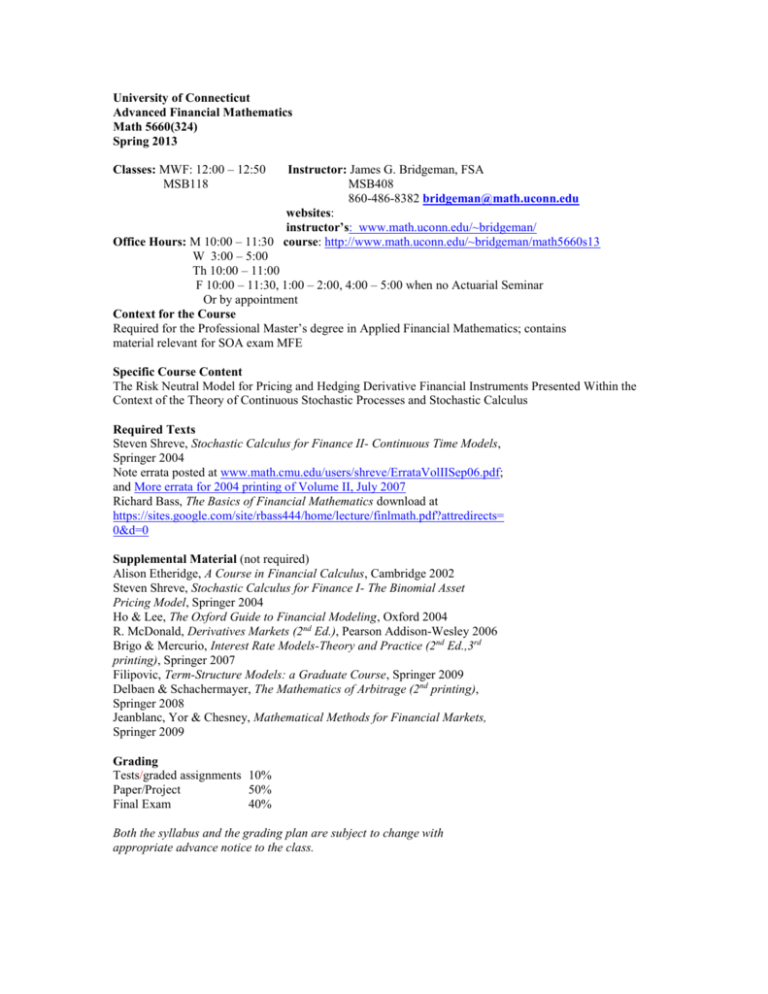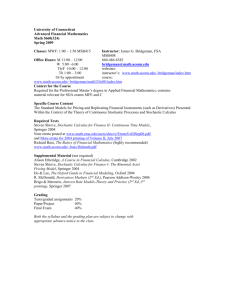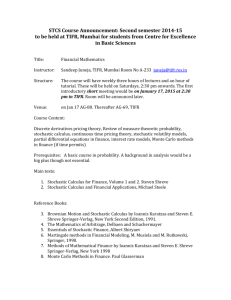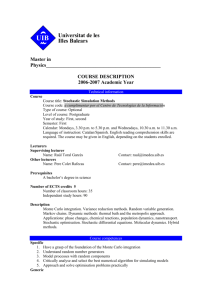
University of Connecticut
Advanced Financial Mathematics
Math 5660(324)
Spring 2013
Classes: MWF: 12:00 – 12:50
MSB118
Instructor: James G. Bridgeman, FSA
MSB408
860-486-8382 bridgeman@math.uconn.edu
websites:
instructor’s: www.math.uconn.edu/~bridgeman/
Office Hours: M 10:00 – 11:30 course: http://www.math.uconn.edu/~bridgeman/math5660s13
W 3:00 – 5:00
Th 10:00 – 11:00
F 10:00 – 11:30, 1:00 – 2:00, 4:00 – 5:00 when no Actuarial Seminar
Or by appointment
Context for the Course
Required for the Professional Master’s degree in Applied Financial Mathematics; contains
material relevant for SOA exam MFE
Specific Course Content
The Risk Neutral Model for Pricing and Hedging Derivative Financial Instruments Presented Within the
Context of the Theory of Continuous Stochastic Processes and Stochastic Calculus
Required Texts
Steven Shreve, Stochastic Calculus for Finance II- Continuous Time Models,
Springer 2004
Note errata posted at www.math.cmu.edu/users/shreve/ErrataVolIISep06.pdf;
and More errata for 2004 printing of Volume II, July 2007
Richard Bass, The Basics of Financial Mathematics download at
https://sites.google.com/site/rbass444/home/lecture/finlmath.pdf?attredirects=
0&d=0
Supplemental Material (not required)
Alison Etheridge, A Course in Financial Calculus, Cambridge 2002
Steven Shreve, Stochastic Calculus for Finance I- The Binomial Asset
Pricing Model, Springer 2004
Ho & Lee, The Oxford Guide to Financial Modeling, Oxford 2004
R. McDonald, Derivatives Markets (2nd Ed.), Pearson Addison-Wesley 2006
Brigo & Mercurio, Interest Rate Models-Theory and Practice (2nd Ed.,3rd
printing), Springer 2007
Filipovic, Term-Structure Models: a Graduate Course, Springer 2009
Delbaen & Schachermayer, The Mathematics of Arbitrage (2nd printing),
Springer 2008
Jeanblanc, Yor & Chesney, Mathematical Methods for Financial Markets,
Springer 2009
Grading
Tests/graded assignments 10%
Paper/Project
50%
Final Exam
40%
Both the syllabus and the grading plan are subject to change with
appropriate advance notice to the class.
Outline & Intended Pace
Week of
Topic(s)
Jan. 21
Main Ideas: Risk-Neutral Pricing & Hedging
Binomial Example; What’s Needed To Generalize It?
Review of Probability - Basics
Jan. 28
Review of Probability – Expectations, Convergence,
Change of Measure
Feb. 4
Information, Filtrations, Independence, Conditioning
Feb. 11
Random Walk and Brownian Motion
Feb. 18
Properties of Brownian Motion
Feb. 25
Stochastic Calculus: Itô’s Integral, Itô’s Lemma
March 4
General Itô Lemma; Black–Scholes Equation
March 11
Multivariate Stochastic Calculus; Levy’s Criterion
Girsanov’s Theorem: Risk-Neutral Measure,
Black-Scholes Formula
March 25
Martingale Representation Theorem: Hedging
Fundamental Theorems of Asset Pricing: existence and
uniqueness of Risk Neutral Measure
April 1
Basic Applications to Financial Assets
April 8
Stochastic Differential Equations; Feynman-Kac Thm.
April 15
Further Topics For Applying the Model
April 22
Further Topics For Applying the Model
April 29
Further Topics For Applying the Model
Final Exam Week of May 6
Text Sections
ch. 1
ch. 1
ch. 2
Sec. 3.1-3.3
Sec. 3.4-3.8
Sec. 4.1-4.4.1
Sec. 4.4.2-4.5
Sec. 4.6, 4.8
Sec. 5.1-5.2
Sec. 5.3-5.4
Sec. 5.5-5.7
Sec. 6.1-6.6
TBD from Ch. 7-10
TBD
TBD
All
Homework
To master the material and be prepared for the final exam you should expect
to do most of the exercises in the assigned portions of the textbook as part of
your study for each chapter. Many of these exercises develop important parts
of the theory and its applications. Specific exercises will be assigned and
they are fair game for the final exam. These usually will not be collected and
graded so it’s up to you to ask questions about the ones you don’t feel
comfortable with.
Tests/graded assignments
At my discretion there may be one to three take home tests and/or graded
assignments given over the course of the semester, at about the level of
difficulty of the text exercises and sometimes drawn directly from the text
exercises.
Paper/Project
You will be expected to produce a term paper or a modeling project, due by
May 6. This can be a topic that you select from chapters 7 thru 10, or a
project that goes beyond what the text presents on a topic covered in chapters
1 thru 6. If you can’t come up with a topic that interests you, one will be
assigned. I will ask you to select your topic by March 25 and will hold you to
that selection.
Both the syllabus and the grading plan are subject to change with
appropriate advance notice to the class.










